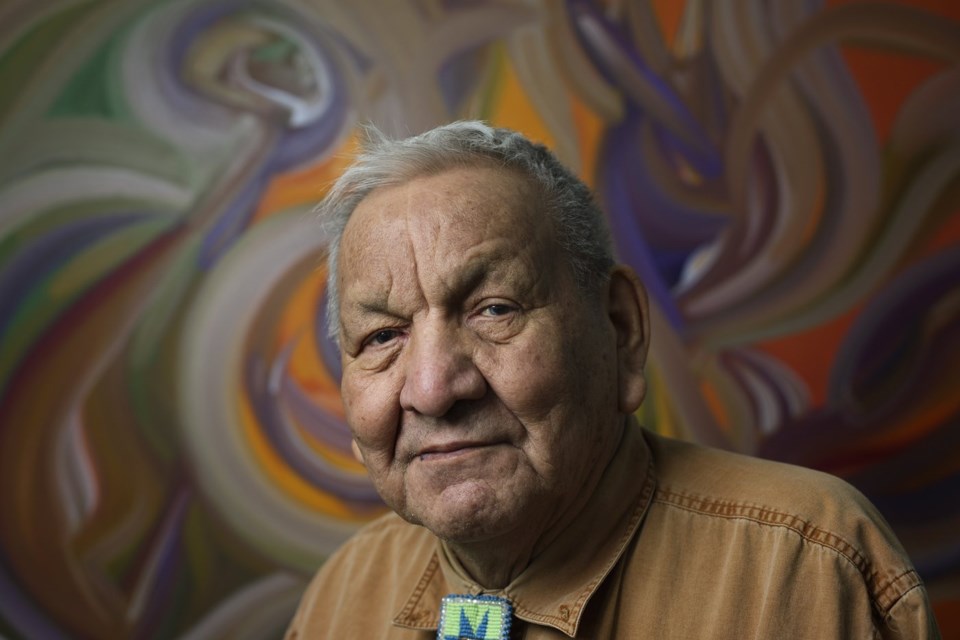EDMONTON — One of Canada's greatest painters, who wedded Indigenous elements to the mainstream of modern art, has died.
Alex Janvier, whose thousands of works hang in private homes and public galleries across the country, was 89.
"Painting says it all for me," Janvier said in a statement in 2012. "It is the Redman talk in colour, in North America's language. Our Creator's voice in colour."
Officials at the Assembly of First Nations annual general meeting announced the death and held a moment of silence in the artist's honour on Wednesday.
Janvier was born Feb. 28, 1935, on the Cold Lake Indian Reserve, now Cold Lake First Nations, northeast of Edmonton. His father, Harry Janvier, was the band's last hereditary chief before federal law forced elected officials on the band.
One of 10 children, Alex Janvier grew up on the land, hunting, fishing and trapping, as well as farming. At the age of eight, he was sent to the Blue Quills Residential School near St. Paul, Alta.
"That kind of story does a lot of unusual things to your life," Janvier recalled. "It tears your language, culture and beliefs. They probably removed a lot of it."
But at the school Janvier had access to pencils, crayons, watercolour paints and lots of paper. By the time he reached his early teens, he was under the tutelage of Carlo Altenberg, an art professor at the University of Alberta, who exposed the young Denesuline to the work of European modernists such as Wassily Kandinsky, Paul Klee and Joan Miro.
After high school, Janvier studied at Alberta's Provincial Institute of Technology and Art in Calgary, now the Alberta University of the Arts. He studied with prominent artists, including Illingworth Kerr and Marion Nicoll.
In 1962, after a brief teaching stint, Janvier took up painting full time — a risky proposition for an Indigenous artist when such work was considered of more ethnological than artistic interest. Still, Janvier was able to make a living as a painter, illustrator and occasional instructor.
Janvier married Jacqueline Wolowski in 1968. They would eventually have six children.
In 1973, with other First Nations artists Norval Morrisseau, Daphne Odjig and Jackson Beardy, he helped found the so-called Indian Group of Seven — more formally known as the Professional Native Indian Artists Inc. — to bring their work to the mainstream.
"We had to open a lot of doors," Janvier recalled. A show in a Montreal gallery was the group's first, and others followed.
"We finally got that rubber stamp and other gallery owners started to open their doors."
Since then, Janvier's work has been shown in galleries across Canada, as well as in Sweden, Paris, London, New York and Los Angeles.
It is widely collected, and commissioned work hangs in the National Gallery and the Royal Alberta Museum, as well as schools, commercial offices, municipal buildings and band offices from coast to coast.
His massive mosaic, Iron Foot Place, has greeted thousands of hockey fans at Edmonton's Rogers Place, home of the Edmonton Oilers of the National Hockey League. He designed a $200 coin for the Royal Canadian Mint.
One of his largest public pieces, painted with his sons, hangs in the Canadian Museum of History — Morning Star-Gambeh Then', which covers 418 square metres and rises for seven storeys.
"His monumental work is a centrepiece of our museum," said Caroline Dromaguet, the museum's president and CEO. "Looking up to discover this work is an unforgettable experience and I am comforted to know that Janvier’s legacy will live on."
Prime Minister Justin Trudeau offered his condolences on social media.
"His art reflected so much of Canada's history, including some of the hardest parts of our story," he said.
Unlike many other First Nations artists of his generation, Janvier's work tends not to come directly from traditional legends and stories. He draws equally on the patterns and bright colours of traditional Denesuline beadwork and the work of painters such as Kandinsky.
But his renowned flowing lines and intricate designs are all his own.
Though generally abstract, Janvier did react to the world around him on his canvasses.
In 1988, his painting Lubicon, with its shocking reds, expressed his anger at how that First Nation was being treated. He completed a series about his time in the residential school, including one called Apple Factory. The Oka crisis in 1990 inspired him to paint O'Kanada.
He received numerous honorary degrees and awards, including the Order of Canada, the Lifetime Achievement Award from the National Aboriginal Achievement Foundation, the Queen Elizabeth II Diamond Jubilee Medal and membership in the Royal Canadian Academy of Arts.
In 2003, Janvier and members of his family opened the Janvier Gallery in Cold Lake, not far from where he was born. Visitors could sometimes meet the artist fresh from the studio, covered in paint-splattered jeans and happy to sit and chat.
He painted into his last days, keeping his fingers nimble by assembling jigsaw puzzles at night.
"I am a free man because I can create," he wrote in 2016. "I thank the Great Spirit for my family and for being able to express myself through my paintings.
"When I die, I want to have a paintbrush in my hand."
This report by The Canadian Press was first published July 10, 2024.
Bob Weber, The Canadian Press




